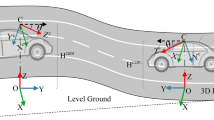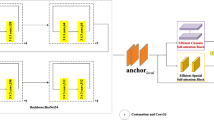Abstract
Recently, many lane line detection methods have been proposed in the field of unmanned driving, and these methods have obtained good results in common conditions, such as sunny and cloudy conditions. However, these methods generally perform poorly in poor visibility conditions, such as foggy and rainy conditions. To effectively solve the problem of lane line detection in a foggy environment, this paper proposes a dual-subnet model that combines a defogging model and a lane line detection model based on stacked hourglass model blocks. To strengthen the features of important channels and weaken the features of nonimportant channels, a channel attention mechanism is introduced into the dual-subnet model. The network uses dilated convolution (DC) to reduce the network complexity and adds a residual block to the defogging subnet to improve the defogging effect and ensure detection accuracy. By loading the pretrained weights of the fog-removing subnets into the dual-subnet model, the visibility is enhanced and the detection accuracy is improved in the foggy environment. In terms of datasets, since there is currently no public dataset of lane lines in foggy environments, this paper uses a standard optical model to synthesize fog and adds a new class of foggy lane line data to TuSimple and CULane. Our model achieves good performance on the new datasets.
Access this chapter
Tax calculation will be finalised at checkout
Purchases are for personal use only
Similar content being viewed by others
References
Narote, S.P., Bhujbal, P.N., Narote, A.S., Dhane, D.M.: A review of recent advances in lane detection and departure warning system. Pattern Recognit. 73, 216–234 (2018)
Lv, C., Cao, D.P., Zhao, Y.F., et al.: Analysis of autopilot disengagements occurring during autonomous vehicle testing. IEEE/CAA J. Automatica Sinica 5(1), 58–68 (2018). https://doi.org/10.1109/JAS.2017.7510745
Pei, S., Wang, S., Zhang, H., et al.: Methods for monitoring and controlling multi-rotor micro-UAVs position and orientation based on LabVIEW. Int. J. Precis. Agric. Aviat. 1(1), 51–58 (2018)
Narote, S.P., Bhujbal, P.N., Narote, A.S., et al.: A review of recent advances in lane detection and departure warning system. Pattern Recogn 73, 216–134 (2018). https://doi.org/10.1016/j.patcog.2017.08.014
Zhao, Z., Zhou, L., Zhu, Q.: Preview distance adaptive optimization for the path tracking control of unmanned vehicle. J. Mech. Eng. 54(24), 166–173 (2018). (in Chinese)
Hillel, A.B., Lerner, R., Levi, D., et al.: Recent progress in road and lane detection: a survey. Mach. Vis. Appl. 25(3), 727–745 (2014)
Zhang, X., Huang, H., Meng, W., et al.: Improved lane detection method based on convolutional neural network using self-attention distillation. Sens. Mater. 32(12), 4505 (2020)
Chao, W., Huan, W., Chunxia, Z., et al.: Lane detection based on gradient-enhancing and inverse perspective mapping validation. J. Harbin Eng. Univ. 35(9), 1156–1163 (2014)
Huang, S.C., Le, T.H., Jaw, D.W.: DSNet: joint semantic learning for object detection in inclement weather conditions. IEEE Trans. Pattern Anal. Mach. Intell. 43(8), 2623–2633 (2020)
Li, B., Peng, X., Wang, Z., et al.: An All-in-One Network for Dehazing and Beyond (2017)
Somawirata, I.K., Utaminingrum, F.: Road detection based on the color space and cluster connecting. In: 2016 IEEE International Conference on Signal Image Process, pp. 118–122. IEEE (2016)
Qi, N., Yang, X., Li, C., Lu, R., He, C., Cao, L.: Unstructured road detection via combining the model-based and feature-based methods. IET Intell. Transp. Syst. 13, 1533–1544 (2019)
Tapia-Espinoza, R., Torres-Torriti, M.: A comparison of gradient versus color and texture analysis for lane detection and tracking. In: 2009 6th Latin American Robotics Symposium, LARS 2009, pp. 1–6 (2009). https://doi.org/10.1109/LARS.2009.5418326
Küçükmanisa, A., Tarım, G., Urhan, O.: Real-time illumination and shadow invariant lane detection on mobile platform. J. Real-Time Image Proc. 16(5), 1781–1794 (2017). https://doi.org/10.1007/s11554-017-0687-2
Wang, Y., Dahnoun, N., Achim, A.: A novel system for robust lane detection and tracking. Signal Process. 92, 319–334 (2012). https://doi.org/10.1016/j.sigpro.2011.07.019
Aly, M.: Real time detection of lane markers in urban streets. In: IEEE Intelligent Vehicles Symposium Proceedings, pp. 7–12 (2008). https://doi.org/10.1109/IVS.2008.4621152
Mammeri, A., Boukerche, A., Lu, G.: Lane detection and tracking system based on the MSER algorithm, Hough transform and kalman filter. In: MSWiM 2014 - Proceedings of 17th ACM International Conference on Modeling, Analysis and Simulation of Wireless and Mobile Systems, pp. 259–266 (2014). https://doi.org/10.1145/2641798.2641807
Mu, C., Ma, X.: Lane detection based on object segmentation and piecewise fitting. TELKOMNIKA Indones J. Electr. Eng. 12(5), 3491–3500 (2014)
Wu, P.-C., Chang, C.-Y., Lin, C.H.: Lane-mark extraction for automobiles under complex conditions. Pattern Recognit. 47(8), 2756–2767 (2014)
Aung, T., Zaw, M.H.: Video based lane departure warning system using hough transform. In: International Conference on Advances in Engineering and Technology, pp. 29–30 (2014)
Marzougui, M., Alasiry, A., Kortli, Y., Baili, J.: A lane tracking method based on progressive probabilistic hough transform. IEEE Access 8, 84893–84905 (2020). https://doi.org/10.1109/ACCESS.2020.2991930
Krizhevsky, I.S., Hinton, G.E.: Imagenet classification with deep convolutional neural networks. In: Advances in Neural Information Processing Systems, pp. 1097–1105 (2012)
Kim, J., Lee, M.: Robust lane detection based on convolutional neural network and random sample consensus. In: Loo, C.K., Yap, K.S., Wong, K.W., Teoh, A., Huang, K. (eds.) ICONIP 2014. LNCS, vol. 8834, pp. 454–461. Springer, Cham (2014). https://doi.org/10.1007/978-3-319-12637-1_57
Gurghian, T.K., Bailur, S.V., Carey, K.J., Murali, V.N.: Deeplanes: end-to-end lane position estimation using deep neural networksa. In: Proceedings of the IEEE Conference on Computer Vision and Pattern Recognition Workshops, pp. 38–45 (2016)
Zhang, W., Mahale, T.: End to end video segmentation for driving: lane detection for autonomous car, arXiv:1812.05914 (2018)
Pan, X., Shi, J., Luo, P., Wang, X., Tang, X.: Spatial as deep: spatial CNN for traffic scene understanding. In: Thirty-Second AAAI Conference on Artificial Intelligence (2018)
Ghafoorian, M., et al.: EL-GAN: Embedding Loss Driven Generative Adversarial Networks for Lane Detection (2019)
Zagoruyko, S., Komodakis, N.: Paying more attention to attention: improving the performance of convolutional neural networks via attention transfer, arXiv:1612.03928 (2016)
Hinton, G., Vinyals, O., Dean, J.: Distilling the knowledge in a neural network, arXiv preprint arXiv:1503.02531 (2015)
Hou, Y., Ma, Z., Liu, C., Loy, C.C.: Learning lightweight lane detection CNNs by self-attention distillation. In: Proceedings of the IEEE International Conference on Computer Vision, pp. 1013–1021 (2019)
Yoo, S., Lee, H., Myeong, H., et al.: End-to-end lane marker detection via row-wise classification. In: 2020 IEEE/CVF Conference on Computer Vision and Pattern Recognition Workshops (CVPRW). IEEE (2020)
Qin, Z., Wang, H., Li, X.: Ultra fast structure-aware deep lane detection. In: Vedaldi, A., Bischof, H., Brox, T., Frahm, J.-M. (eds.) ECCV 2020. LNCS, vol. 12369, pp. 276–291. Springer, Cham (2020). https://doi.org/10.1007/978-3-030-58586-0_17
Tabelini, L., Berriel, R., Paixao, T.M., Badue, C., De Souza, A.F., Oliveira-Santos, T.: PolyLaneNet: lane estimation via deep polynomial regression. In: ICPR (2020)
Feng, Z., Guo, S., Tan, X., et al.: Rethinking efficient lane detection via curve modelling. In: Proceedings of the IEEE/CVF Conference on Computer Vision and Pattern Recognition, pp. 17062–17070 (2022)
Ko, Y., Lee, Y., Azam, S., et al.: Key Points Estimation and Point Instance Segmentation Approach for Lane Detection (2020)
The tusimple lane challenge. http://benchmark.tusimple.ai/
Author information
Authors and Affiliations
Corresponding author
Editor information
Editors and Affiliations
Rights and permissions
Copyright information
© 2022 ICST Institute for Computer Sciences, Social Informatics and Telecommunications Engineering
About this paper
Cite this paper
Bi, Zq., Deng, Ka., Zhong, W., Shan, Mj. (2022). An Improved Dual-Subnet Lane Line Detection Model with a Channel Attention Mechanism for Complex Environments. In: Gao, H., Wang, X., Wei, W., Dagiuklas, T. (eds) Collaborative Computing: Networking, Applications and Worksharing. CollaborateCom 2022. Lecture Notes of the Institute for Computer Sciences, Social Informatics and Telecommunications Engineering, vol 461. Springer, Cham. https://doi.org/10.1007/978-3-031-24386-8_27
Download citation
DOI: https://doi.org/10.1007/978-3-031-24386-8_27
Published:
Publisher Name: Springer, Cham
Print ISBN: 978-3-031-24385-1
Online ISBN: 978-3-031-24386-8
eBook Packages: Computer ScienceComputer Science (R0)




